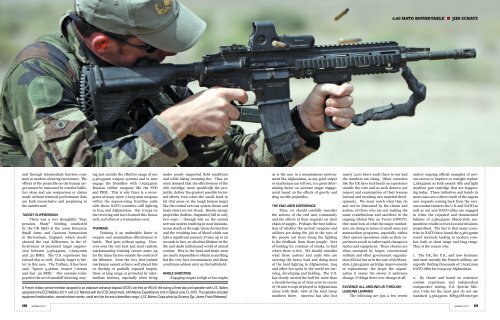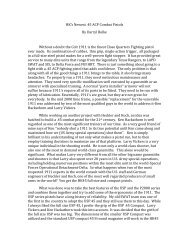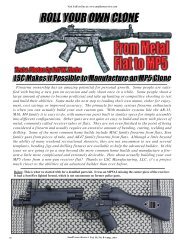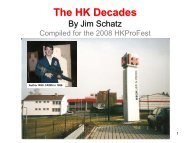DO WE NEED A NEW SERVICE RIFLE CARTRIDGE? - HKPro.com
DO WE NEED A NEW SERVICE RIFLE CARTRIDGE? - HKPro.com
DO WE NEED A NEW SERVICE RIFLE CARTRIDGE? - HKPro.com
Create successful ePaper yourself
Turn your PDF publications into a flip-book with our unique Google optimized e-Paper software.
5.56 NATO ROUNDTABLE JIM SCHATZ<br />
and through intermediate barriers <strong>com</strong>mon<br />
in modern shooting encounters. The<br />
effects of the projectile on the human target<br />
cannot be measured by exterior ballistics<br />
alone and any <strong>com</strong>parison or claims<br />
made without terminal performance data<br />
are both inconclusive and perplexing to<br />
the uninformed.<br />
TARGET SUPPRESSION<br />
There was a very thoughtful “Suppression<br />
Study” briefing conducted<br />
by the UK MoD at the 2009 European<br />
Small Arms and Cannons Symposium<br />
in Shrivenham, England, which clearly<br />
showed the vast differences in the effectiveness<br />
of personnel target suppression<br />
between 5.56x45mm, 7.62x51mm<br />
and .50 BMG. The U.S. experience has<br />
echoed this as well. Clearly larger is better<br />
in this case. The Taliban, it has been<br />
said, “Ignore 5.56mm, respect 7.62mm<br />
and fear .50 BMG.” Our enemies today<br />
practice the art of standoff shooting, staying<br />
just outside the effective range of our<br />
5.56x45mm weapon systems and in turn<br />
engage the friendlies with 7.62x54mm<br />
Russian caliber weapons like the SVD<br />
and PKM. This is why there is a resurgence<br />
of many more 7.62x51mm weapons<br />
within the maneuvering frontline units<br />
with those NATO countries still fighting<br />
in Iraq and Afghanistan. Our troops on<br />
the receiving end have learned this lesson<br />
well, and often at a tremendous cost.<br />
TRAINING<br />
Training is an undeniable factor in<br />
weapon and ammunition effectiveness in<br />
battle. That goes without saying. However<br />
even the very best and most realistic<br />
marksmanship training cannot make up<br />
for the many factors outside the control of<br />
the riflemen. Even the very best trained<br />
marksman cannot achieve well placed hits<br />
on fleeting or partially exposed targets,<br />
those at long range or protected by intermediate<br />
barriers, especially when firing<br />
under poorly supported field conditions<br />
and while taking in<strong>com</strong>ing fire. Thus we<br />
must demand that the effectiveness of the<br />
rifle cartridge, more specifically the projectile,<br />
deliver the greatest possible terminal<br />
effects even when the small, hard to<br />
hit vital areas on the tough human target<br />
like the central nervous system (brain and<br />
brain stem) are not struck. Kinetic energy<br />
projectiles (bullets, fragments) kill in only<br />
two ways – through hits on the central<br />
nervous system resulting in near instantaneous<br />
death or through tissue destruction<br />
and the resulting loss of blood which can<br />
take a significant amount of time, up to 50<br />
seconds in fact, an absolute lifetime in the<br />
life and death millisecond world of armed<br />
<strong>com</strong>bat. Hits to the head and brain stem<br />
are nearly impossible to obtain in anything<br />
but the very best circumstances and those<br />
conditions seldom exist on the battlefield.<br />
ANGLE SHOOTING<br />
Engaging targets at high or low angles<br />
A French military service member assigned to an explosive ordnance disposal (EOD) unit fires an HK416 rifle during a three-day joint operation with U.S. Sailors<br />
assigned to the EOD Mobile Unit 11 and U.S. Marines with the EOD Detachment, 24th Marine Expeditionary Unit in Djibouti June 13, 2010. The operation included<br />
equipment familiarization, scenario-driven events, small arm live fire and a demolition range. (U.S. Marine Corps photo by Gunnery Sgt. James Frank/Released)<br />
as is the case in a mountainous environment<br />
like Afghanistan, as any good sniper<br />
or marksman can tell you, is a great determining<br />
factor on accurate target engagement<br />
based on the effects of gravity and<br />
drag on rifle projectiles.<br />
THE END USER EXPERIENCE<br />
Then, we should carefully consider<br />
the actions of the end user <strong>com</strong>munity<br />
and the effects of their requests on their<br />
chain of supply. Perhaps the best indication<br />
of whether the current weapons and<br />
calibers are doing the job in the eyes of<br />
the people out front doing the fighting<br />
is the feedback from those people. Sort<br />
of looking for columns of smoke, to find<br />
where there is fire. We should consider<br />
what those nations and units who are<br />
carrying the heavy load and doing most<br />
of the hard fighting in Afghanistan, Iraq<br />
and other hot spots in the world are carrying,<br />
developing and fielding. The U.S.<br />
has clearly carried the ball for more than<br />
a decade having as of June 2010 in excess<br />
of 78,000 troops deployed in Afghanistan<br />
alone with ISAF, 66% of the total troop<br />
numbers there. America has also lost<br />
nearly 1,100 brave souls there to war and<br />
the numbers are rising. Other countries<br />
like the UK have real hands on experience<br />
outside the wire and as such deserve our<br />
respect and examination of their lessons<br />
learned and resulting new material developments.<br />
We must watch what they do<br />
and not be distracted by the claims and<br />
actions of those who are not making the<br />
same contributions and sacrifices in the<br />
ongoing Global War on Terror (GWOT).<br />
One must look at what the major <strong>com</strong>batants<br />
are doing in terms of small arms and<br />
ammunition programs, especially within<br />
their special operations units as their experiences<br />
result in rather rapid changes in<br />
tactics and equipment. These choices are<br />
often emulated by larger, conventional<br />
military and other government organization<br />
(OGAs) but as in the case with SS109-<br />
style 5.56x45mm cartridge improvements<br />
or replacement, the larger the organization<br />
it seems the slower it embraces<br />
change, if things there ever change at all.<br />
EVIDENCE ALL AROUND US THROUGH<br />
LESSONS LEARNED<br />
The following are just a few recent<br />
and/or ongoing official examples of serious<br />
moves to improve or outright replace<br />
5.56x45mm as both assault rifle and light<br />
machine gun cartridge that are happening<br />
today. These initiatives and trends in<br />
most cases are a direct result of the urgent<br />
user requests <strong>com</strong>ing back from the various<br />
<strong>com</strong>bat theaters the U.S. and NATO as<br />
well as our non-NATO allies are engaged<br />
in when the repeated and documented<br />
failures of 5.56x45mm SS109-style ammunition<br />
results in lives lost and missions<br />
jeopardized. The fact is that many countries<br />
in NATO have found the 5.56x45mm<br />
round seriously lacking in modern <strong>com</strong>bat,<br />
both at short range and long range.<br />
Thus is the reason why:<br />
1. The UK, the U.S., and now Germany<br />
and most recently the French military are<br />
urgently fielding thousands of 7.62x51mm<br />
NATO rifles for troop use Afghanistan.<br />
2. By choice and based on extensive<br />
<strong>com</strong>bat experience and independent<br />
<strong>com</strong>parative testing, U.S. Special Mission<br />
Units for the most part do not use<br />
standard 5.56x45mm M855/SS109-type<br />
120 SPRING 2011 SPRING 2011 121






